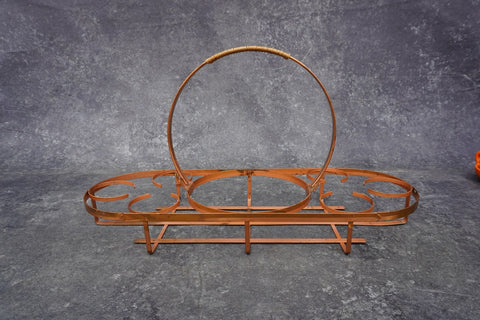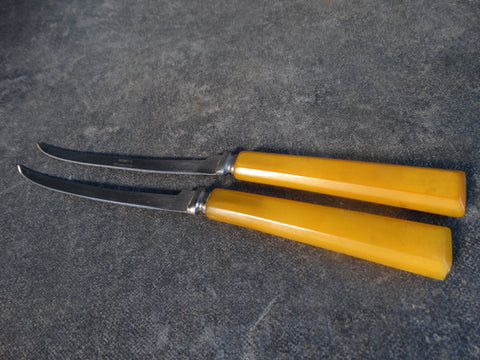Cellini-Craft Round Tray with Hand-set Spanish Tile A2352
Measures 19 3/4" in diameter.
Evanston metalsmith Hans Max Grag combined popular modern materials: aluminum; colorful ceramic tile; and Bakelite, an early heat-resistant plastic to create this unique line of jewelry and table ware called Argental (meaning silver-like), introduced by Cellini Craft, Ltd. in 1933. Advertised as "new, lightweight, silver-like, non-tarnishing, strong as steel but entirely hand wrought," Argental was stylish but inexpensive—an important factor during the Great Depression, when few could afford to purchase costly sterling silver tableware.
Cellini Craft, Ltd., was a subsidiary business of The Cellini Shop, a small Evanston retailer specializing in handwrought jewelry and silver tableware, owned by brothers Ernest and Walter Gerlach. Ernest, trained in Marshall Field & Company's crafts shops in Chicago, opened the shop in 1914; Walter, who studied at the Art Institute of Chicago, joined him as designer and silversmith in 1919. Hans Grag, who had owned an art metal studio in his native Germany, joined the firm around 1926.
Soon after Hans Grag's arrival, they began making hollowware in hammered aluminum in addition to handwrought silver. He executed experimental designs in silver-plated copper. If they sold well, they would be reproduced in quantity in sterling, silver plate, or aluminum. In 1933, Walter Gerlach and Grag formed Cellini Craft, Ltd. with New York giftware dealer Max Wille, whose role was to create a national market for the firm's Argental products.
In its Evanston workshop, Cellini Craft metalsmiths hammered out a wide range of serving pieces—everything from syrup pitchers to sugar bowls and creamers; butter knives to salad servers; and trays in a variety of sizes. Casserole dishes with Pyrex® inserts were particularly popular, with some lids decorated with ceramic tile, Bakelite knobs, or colorful enamel escutcheon plates. While labor-saving machinery was used to form bodies of some hollowware, complex pieces combining many shapes and materials, such as this chafing dish and candelabra, were entirely made by hand.
After Hans Grag and Max Wille ended their affiliation with the company in 1949, Cellini Craft was reincorporated by Walter Gerlach and his siblings, Ernest and Martha. They continued to market their products nationally until 1957, when the Cellini Craft patterns were sold to brothers Scott and Julius Randahl, who operated a metalsmithing shop and retail store in neighboring Skokie.









